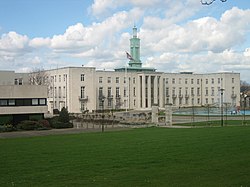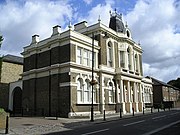Waltham Forest Town Hall: Difference between revisions
Created page with "{{Infobox building |name=Waltham Forest Town Hall |county=Essex |picture=Walthamstow Town Hall 20 Apr 2006.jpg |picture caption=Waltham Forest Town Hall |os grid ref=TQ3771899..." |
|||
| Line 21: | Line 21: | ||
==History== | ==History== | ||
[[File:Walthamstow Old Town Hall - geograph.org.uk - 1463183.jpg|left|thumb|180px|The old town hall in Orford Road]] | [[File:Walthamstow Old Town Hall - geograph.org.uk - 1463183.jpg|left|thumb|180px|The old town hall in Orford Road]] | ||
The town hall was commissioned to replace an earlier, Italianate style town hall built in Orford Road in 1876 (and which is now the Connaught Hospital).<ref>{{NHLE|1191150|Old Town Hall, Wathamstow|grade= | The town hall was commissioned to replace an earlier, Italianate style town hall built in Orford Road in 1876 (and which is now the Connaught Hospital).<ref>{{NHLE|1191150|Old Town Hall, Wathamstow|grade=II}}</ref> | ||
The site chosen for the new building was previously occupied by Chestnuts Farm, also known as Clay Farm.<ref name=hidden>{{cite web|url=http://hidden-london.com/nuggets/walthamstow-town-hall/ |title=Walthamstow Town Hall |publisher=Hidden London |date=|accessdate=12 April 2020}}</ref> The building was commissioned by the Municipal Borough of Walthamstow and designed by Philip Dalton Hepworth<ref>{{cite web |url=http://www.scottisharchitects.org.uk/architect_full.php?id=201575 |title=Philip Dalton Hepworth|publisher=Dictionary of Scottish Architects |date=|accessdate=12 April 2020}}</ref> in the Nordic Classical style.<ref name=hidden/> The foundation stone, in which contemporary artifacts were placed, was laid in 1938.<ref>{{cite web|last=Last |first=Londonist |url=http://londonist.com/2012/08/top-10-things-to-do-in-the-borough-of-waltham-forest.php |title=Top 10 Things To Do In The Borough Of Waltham Forest |publisher=Londonist |date=21 August 2012 |accessdate=12 April 2020}}</ref> Construction of the building, which is built of Portland stone, was interrupted by the Second World War and it was not completed until 1942.<ref name="autogenerated1">Novotny, Lukas. Page 34. Modern London. White Lion Publishing; 2018. {{ISBN|978-0-7112-3972-2}}.</ref><ref>{{cite web|url=https://www.c20society.org.uk/wp-content/uploads/2013/03/2012-2403-CivicPlungeRevisitedlowres2.pdf|title=The Civic Plunge Revisited|date=24 March 2012|publisher=Twentieth Century Society|accessdate=25 April 2020}}</ref> Five statues carved by John Francis Kavanagh were installed on the rear of the council chamber and 16 relief sculptures also by him were erected on the portico piers.<ref name=hidden/> | The site chosen for the new building was previously occupied by Chestnuts Farm, also known as Clay Farm.<ref name=hidden>{{cite web|url=http://hidden-london.com/nuggets/walthamstow-town-hall/ |title=Walthamstow Town Hall |publisher=Hidden London |date=|accessdate=12 April 2020}}</ref> The building was commissioned by the Municipal Borough of Walthamstow and designed by Philip Dalton Hepworth<ref>{{cite web |url=http://www.scottisharchitects.org.uk/architect_full.php?id=201575 |title=Philip Dalton Hepworth|publisher=Dictionary of Scottish Architects |date=|accessdate=12 April 2020}}</ref> in the Nordic Classical style.<ref name=hidden/> The foundation stone, in which contemporary artifacts were placed, was laid in 1938.<ref>{{cite web|last=Last |first=Londonist |url=http://londonist.com/2012/08/top-10-things-to-do-in-the-borough-of-waltham-forest.php |title=Top 10 Things To Do In The Borough Of Waltham Forest |publisher=Londonist |date=21 August 2012 |accessdate=12 April 2020}}</ref> Construction of the building, which is built of Portland stone, was interrupted by the Second World War and it was not completed until 1942.<ref name="autogenerated1">Novotny, Lukas. Page 34. Modern London. White Lion Publishing; 2018. {{ISBN|978-0-7112-3972-2}}.</ref><ref>{{cite web|url=https://www.c20society.org.uk/wp-content/uploads/2013/03/2012-2403-CivicPlungeRevisitedlowres2.pdf|title=The Civic Plunge Revisited|date=24 March 2012|publisher=Twentieth Century Society|accessdate=25 April 2020}}</ref> Five statues carved by John Francis Kavanagh were installed on the rear of the council chamber and 16 relief sculptures also by him were erected on the portico piers.<ref name=hidden/> | ||
Latest revision as of 12:35, 19 October 2020
| Waltham Forest Town Hall | |
|
Essex | |
|---|---|
 Waltham Forest Town Hall | |
| Type: | Town hall |
| Location | |
| Grid reference: | TQ37718991 |
| Location: | 51°35’28"N, 0°-0’49"W |
| Town: | Walthamstow |
| History | |
| Built 1942 | |
| By: | Philip Dalton Hepworth |
| Town hall | |
| Nordic Classical | |
| Information | |
| Owned by: | Waltham Forest Council |
Waltham Forest Town Hall, also known as Walthamstow Town Hall, is a municipal building in Walthamstow, Essex. It was built for Walthamstow's then borough council and, unusually, it was completed during the War. It remains the seat of the council's successor council.
The town hall is a Grade II Listed Building.[1]
History

The town hall was commissioned to replace an earlier, Italianate style town hall built in Orford Road in 1876 (and which is now the Connaught Hospital).[2]
The site chosen for the new building was previously occupied by Chestnuts Farm, also known as Clay Farm.[3] The building was commissioned by the Municipal Borough of Walthamstow and designed by Philip Dalton Hepworth[4] in the Nordic Classical style.[3] The foundation stone, in which contemporary artifacts were placed, was laid in 1938.[5] Construction of the building, which is built of Portland stone, was interrupted by the Second World War and it was not completed until 1942.[6][7] Five statues carved by John Francis Kavanagh were installed on the rear of the council chamber and 16 relief sculptures also by him were erected on the portico piers.[3]
The assembly hall was used as a municipal meal centre during the Second World War.[8]
The building was transferred to the new Waltham Forest council in 1965 and has been the seat of government for that authority since then.
The assembly rooms have hosted concerts by notable artists such as Plácido Domingo and Yehudi Menuhin.[9]
Outside links
| ("Wikimedia Commons" has material about Waltham Forest Town Hall) |
References
- ↑ National Heritage List 1190868: Waltham Town Hall (Grade II listing)
- ↑ National Heritage List 1191150: Old Town Hall, Wathamstow (Grade II listing)
- ↑ "Philip Dalton Hepworth". Dictionary of Scottish Architects. http://www.scottisharchitects.org.uk/architect_full.php?id=201575. Retrieved 12 April 2020.
- ↑ Last, Londonist (21 August 2012). "Top 10 Things To Do In The Borough Of Waltham Forest". Londonist. http://londonist.com/2012/08/top-10-things-to-do-in-the-borough-of-waltham-forest.php. Retrieved 12 April 2020.
- ↑ Novotny, Lukas. Page 34. Modern London. White Lion Publishing; 2018. ISBN 978-0-7112-3972-2.
- ↑ "The Civic Plunge Revisited". Twentieth Century Society. 24 March 2012. https://www.c20society.org.uk/wp-content/uploads/2013/03/2012-2403-CivicPlungeRevisitedlowres2.pdf. Retrieved 25 April 2020.
- ↑ 'London's Town Halls' (Historic England), page 195
- ↑ "Transforming the heart of Waltham Forest". Waltham Forest Council. 31 October 2019. https://www.walthamforest.gov.uk/content/transforming-heart-waltham-forest. Retrieved 12 April 2020.
